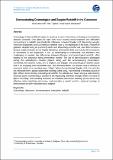Demonstrating cosmological and Doppler redshift in the classroom
Abstract
Cosmology is often a difficult subject to teach as it can involve many confusing and sometimes abstract concepts. One particular topic with many existing misconceptions and difficulties surrounding it is redshift, specifically the difference between Doppler shift (due to the peculiar velocities of galaxies) and cosmological redshift (due to the expansion of the side). Redshift of galaxies, despite being an extremely useful and interesting scientific tool, can often become a tedious subject to teach as it is largely theoretical and usually does not include demonstrations or interaction in the classroom. It can be challenging to understand, and therefore also challenging to explain, the differences between Doppler and cosmological redshift, often leading to this distinction being overlooked entirely. The set of demonstrations developed during this astrophysics masters project, along with the accompanying presentation, worksheet, and teacher notes, aim to explain both Doppler and cosmological redshift clearly and in an engaging and memorable way. The demonstrations use remote control vehicles to represent peaks of a travelling wave of light. When demonstrating Doppler shift, the vehicles are released from a plastic board that is being pulled away, representing a receding source of light. When demonstrating cosmological redshift, the vehicles are driven along a wide stretchy exercise band, representing a section of the expanding Universe through which this wave of light is travelling. This teaching resource will introduce interactive learning, proven to be very effective when teaching astronomy, and provides a useful and fun physical analogy to demonstrate an often-misunderstood subject.
Citation
Marshall , O , Tojeiro , R & Weijmans , A-M 2022 , Demonstrating cosmological and Doppler redshift in the classroom . in M S Anfres , D Garcia-Almiñana , G Detrell , A Garcia-Rigo , R M García Alarcia , G M Homar & D G Díez (eds) , Proceedings of the 4 th Edition Symposium on Space Educational Activities : April 27th, 28th, 29th 2022, Barcelona, Spain . SSEA Proceedings , Universitat Politècnica de Catalunya , Barcelona , pp. 563-568 , 4th Symposium on Space Educational Activities , Barcelona , Spain , 27/04/22 . https://doi.org/10.5821/conference-9788419184405.098 conference
Publication
Proceedings of the 4th Edition Symposium on Space Educational Activities
Type
Conference item
Collections
Items in the St Andrews Research Repository are protected by copyright, with all rights reserved, unless otherwise indicated.

